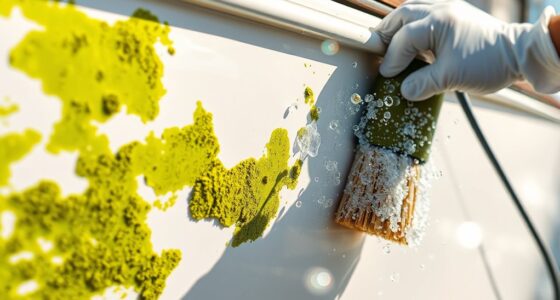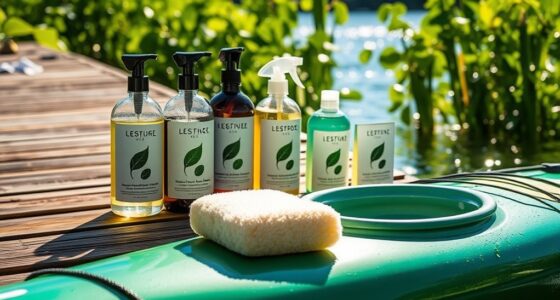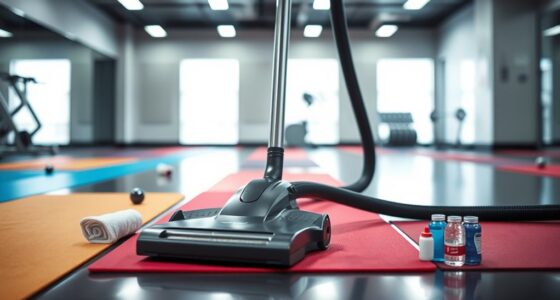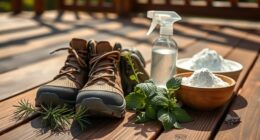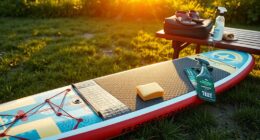Cleaning and lubricating your kayak paddles and hardware is essential for their performance and longevity. Rinse your paddles with fresh water after each use to remove saltwater and dirt. Inspect for cracks or signs of wear regularly. Use marine-grade lubricant on metal hardware to prevent rust. Store everything in a cool, dry place, away from direct sunlight. Proper care makes a big difference in maintaining your gear, and there’s more to know about keeping it in top shape.
Key Takeaways
- Rinse paddles with fresh water after each use to prevent saltwater and dirt damage.
- Inspect paddles for cracks or damage and repair before using them.
- Regularly check screws and bolts for rust or corrosion, replacing any compromised hardware.
- Apply marine-grade lubricant to metal components to create a moisture barrier and prevent rust.
- Store kayaks and paddles in a cool, dry place, away from direct sunlight to avoid deformation.
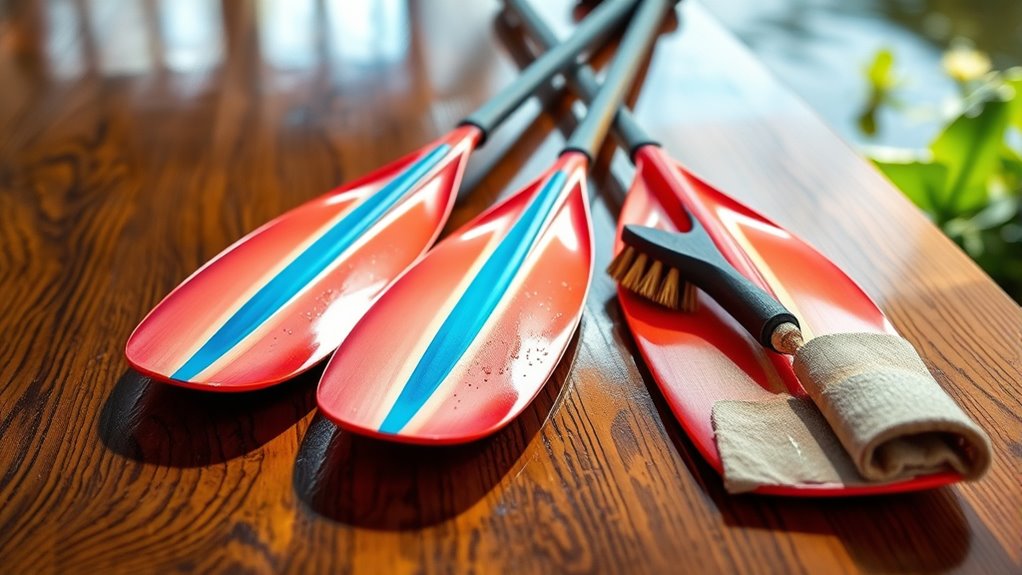
When you hit the water with your kayak, ensuring your paddles and hardware are in top shape is vital for a smooth ride. Regular paddle maintenance and care can greatly enhance your experience on the water. Start by giving your paddles a thorough cleaning after each use. Saltwater and dirt can accumulate and lead to long-term damage. Use fresh water to rinse off any debris, and don’t forget to pay attention to the blade edges, as they can collect grime that affects performance.
Ensuring your paddles and hardware are well-maintained is essential for a smooth kayaking experience.
Once you’ve rinsed the paddles, inspect them for any signs of wear or damage. Look for cracks, splinters, or delamination. If you notice any issues, you might need to repair or replace them before heading out again. For wooden paddles, applying a light coat of oil can help maintain the wood’s integrity, while fiberglass or plastic paddles benefit from a simple wipe-down.
Next, let’s talk about hardware corrosion. Your kayak’s hardware, such as screws, bolts, and clips, plays an important role in its overall functionality. Over time, exposure to water, especially saltwater, can lead to corrosion, which can jeopardize your safety on the water. After each trip, inspect all hardware for any signs of rust or deterioration. If you find any corroded parts, it’s important to replace them immediately.
To prevent hardware corrosion, consider applying a marine-grade lubricant to all metal components. This will create a barrier against moisture and prevent rust from forming. Make it a habit to lubricate the moving parts, such as hinges and clamps, before every outing. This small step can save you from bigger issues down the line and ensure that everything operates smoothly when you need it most. Maintaining proper hardware corrosion prevention is essential for ensuring long-term use of your equipment.
Finally, store your kayak and paddles properly to extend their life. Keep them in a cool, dry place, away from direct sunlight. Avoid stacking heavy items on top of them, which can cause deformation. By dedicating time to paddle maintenance and addressing hardware corrosion proactively, you’ll enjoy a safer, more enjoyable time on the water. Taking these simple steps can make a world of difference, ensuring you’re always ready for your next kayaking adventure.
Frequently Asked Questions
How Often Should I Replace My Kayak Paddles?
You should replace your kayak paddles every few years, depending on how often you use them and their condition. Regular paddle blade maintenance can extend their lifespan, but if you notice cracks or significant wear, it’s time for a new pair. Additionally, if you’ve adjusted the paddle length frequently and it no longer fits properly, consider replacing them. Keeping your paddles in good shape ensures a better experience on the water.
Can I Use WD-40 on My Kayak Hardware?
You might think using WD-40 is a quick fix for your kayak hardware, but it’s not the best choice for kayak paddle maintenance. Instead, select a silicone-based lubricant to prevent hardware corrosion. WD-40 can attract dirt and grime, which can lead to more issues down the line. Regularly clean and lubricate your hardware with the right products to ensure smooth operation and extend your kayak’s lifespan.
What Are the Best Materials for Kayak Paddles?
The best materials for kayak paddles include plastic, fiberglass, and carbon fiber. Each material offers a different balance of weight, durability, and cost. For instance, plastic paddles are affordable and tough, while fiberglass paddles provide a good mix of lightweight design and strength. Carbon fiber paddles excel in performance, being the lightest and most efficient but also the priciest. Consider your paddle design preferences and budget when choosing the right material for your adventures.
How Do I Store My Kayak Paddles Properly?
To store your kayak paddles properly, keep them in a cool, dry place, ideally out of direct sunlight. Did you know that UV exposure can degrade paddle materials by up to 50%? For paddle grip maintenance, wrap them in a soft cloth to prevent scratches, and consider using a padded bag. If your paddles show wear, don’t hesitate to schedule paddle blade replacement to keep them in top shape for your next adventure!
Are There Eco-Friendly Cleaning Products for Paddles?
Yes, there are eco-friendly cleaning products for your paddles! Look for biodegradable cleaners that effectively remove grime without harming the environment. You can also use natural paddle lubricants to keep your gear in great shape. These products help maintain performance while being gentle on nature. When you choose eco-friendly options, you not only care for your paddles but also protect the water you love to explore.
Conclusion
By keeping your kayak paddles and hardware clean and well-lubricated, you’ll guarantee they perform at their best for years to come. Remember, “a stitch in time saves nine”—a little maintenance now can prevent bigger problems later. So, make it a habit to check and care for your gear after each outing. With just a bit of effort, you’ll enjoy smoother paddling and a more enjoyable time on the water. Happy kayaking!



